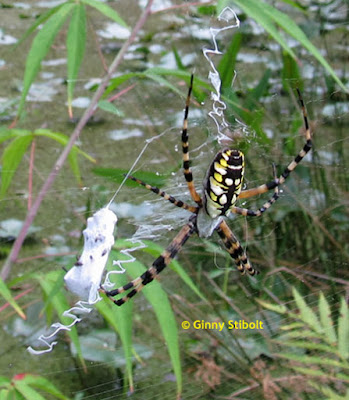 |
| The zebra longwing butterfly (Heliconius charithonia) drinks at the snow squarestem. |
Zebra longwing butterflies that is...
This year we’ve had a huge jump in population, so our property is aflutter with all their striped glory. They don’t have deep wing beats like a lot of floppy butterflies–their wings hardly move as they fly. They are skittish compared to some other butterflies, but they are mesmerizing.This is Florida’s state butterfly and deservedly so, there are more sightings in this state than others. The larval food is the passion vine (Pasiflora spp), but they like it best when it’s grown in the shade.
I’ve been trying for years to create a welcoming habitat for the zebra longwings, so finally we’ve reached the point where this could happen and now we’re teeming with zebras.
 |
| A zebra longwing lays eggs on passion vine leaves. |
On their Team
To attract the butterflies and moths, the most important ingredient is the plants that the caterpillars can eat. The female butterfly tastes the plants with her feet and many will lay their eggs on only one type of plant. Many people know that monarchs need milkweed (Asclepias spp), but zebras need passion vine. If you don’t have the larval food, your butterfly population will be limited at best. |
| Someone has been munching on my passion vine. Yay! |
As butterfly gardeners, we cheer when we see our plants being eaten by caterpillars. I have planted maypop, a Florida native passion vine (Passiflora incarnata). It has done well and when it sends up sprouts in odd places, I transplant them to other, more appropriate sites in the landscape.
See my post, Maypop: a native butterfly and bee magnet.
Nectar Plants
When most people think of a butterfly garden, they think of the beautiful nectar plants that are necessary for the adults, and they are important. But without feeding the larvae (aka caterpillars), your success as a butterfly gardener will always be limited. |
| The zebra longwings like various types of nectar. |
One of my most popular nectar plants right now is the snow squarestem (Melanthera nivea), which is featured in the following gallery of visitors. See my post, Snow Squarestem; A bee and butterfly magnet. In this post I mention the problem of its rangy or sloppy habits at the end of the season when it gets too tall for its stems. for the last few years,I've trimmed the stems back at the edges of the gardens and tapered up to the stems growing in the middle of the plant. So far this strategy is working to keep it neat. But with all the beautiful buzzing and busyness around the blooms, who really cares if a stem droops?
In late summer, my dotted horsemint will also add to the mix. See another post on this nectar plant: An Inch-by-Inch Decoration Feat. And then, later in the fall, the goldenrods and asters will support the adults.
Here’s a gallery of some of the visitors seen one week in September around the snow squarestem plants.
 |
| A black swallowtail (Papilio polyxenes). Larval food is the carrot family. |
 |
| A black swallowtail hanging upside down and small gray hairstreak (Strymon melinus). The gray hairstreak’s wide range of larval foods includes members of the pea and mallow families. |
 |
 |
| Polka-dotted wasp moth (Syntomeida epilais). Larval food includes member of the dogbane family: notably the oleanders. See my post An Exception to the Rules. |
A no-spot ladybird beetle (Cycloneda munda) must have found some aphids to eat here. |
Are you a team member for the butterflies?
You’ll know when you’re a full-fledged team member when your yard is teeming with butterflies and other pollinators.For more information including larval and nectar food sources on zebra longwings and other butterflies, see the Butterflies and Moths website.
© Ginny Stibolt


